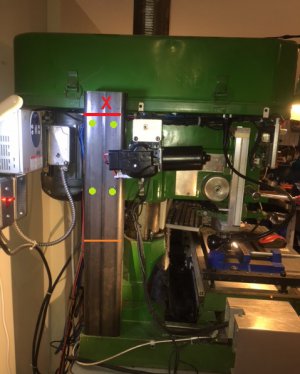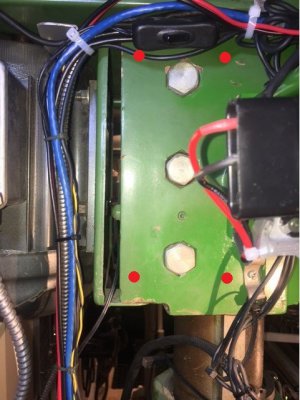I'm thinking about adding a linear bearing to preserve alignment on my round column mill.
I have a stout piece of 2x4 rectangular tubing (see image), I will need to shave a couple of inches off the overall length and then cut it in roughly the center.
For mounting the bottom half, I can mill a rectangular block that will be bolted to the base and fit snugly inside the tube, the tube can then be bolted to the block.
For mounting the upper half I will need to drill and tap the head (probably 4 places) two on either side of the three large bolts (see 2nd image)
I would think there is a fair bit of stress in the head, and I want to make sure I'm not introducing an oportunity for a stress crack to occur in the head as a result of the four additional holes I will add.
Thoughts on drilling the head? Yes, no, if yes what size bolts or studs, I'm thinking smaller is better, perhaps 4 x 1/4", or perhaps 4 x5/16"
Once the two pieces are mounted I will mount a linear bearing, or possible a pair in parallel on the wide face of the rectangular tube, perhaps something like this:
Note the head is in the lowest position in the image. The linear bearings will straddle the cut (orange line).
I have a stout piece of 2x4 rectangular tubing (see image), I will need to shave a couple of inches off the overall length and then cut it in roughly the center.
For mounting the bottom half, I can mill a rectangular block that will be bolted to the base and fit snugly inside the tube, the tube can then be bolted to the block.
For mounting the upper half I will need to drill and tap the head (probably 4 places) two on either side of the three large bolts (see 2nd image)
I would think there is a fair bit of stress in the head, and I want to make sure I'm not introducing an oportunity for a stress crack to occur in the head as a result of the four additional holes I will add.
Thoughts on drilling the head? Yes, no, if yes what size bolts or studs, I'm thinking smaller is better, perhaps 4 x 1/4", or perhaps 4 x5/16"
Once the two pieces are mounted I will mount a linear bearing, or possible a pair in parallel on the wide face of the rectangular tube, perhaps something like this:
Note the head is in the lowest position in the image. The linear bearings will straddle the cut (orange line).
Attachments
Last edited:




